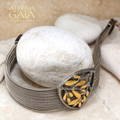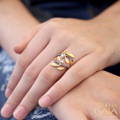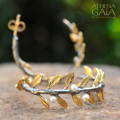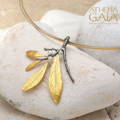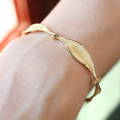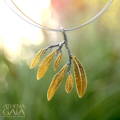+1 (862) 222-0442 (EST)
The Olive in Ancient Art
The Olive in Ancient Art
A symbol through the ages
by Maria Evangelatou

Those of us who love Mediterranean cuisine know how much it owes to the full flavor of olive oil.
And those lucky enough to have travelled in Mediterranean lands are well familiar with the beauty of olive trees that animate the landscape with their silvery canopies and sculptural trunks.

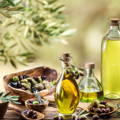
Being one of the most widespread, long-lived, resilient, and generous plants of the Mediterranean climate, the olive tree has offered significant gifts to civilizations past and present.
Since antiquity, olive oil has been central in food preparation, bodily care, healing, and rituals and played a prominent role in the economy of Greek cities. Therefore, the olive tree and its branches became symbols of prosperity, success, long life, and peace and they featured prominently in Greek myths and art.

Photos above: A table of local delicacies from Mani in the Peloponnese photographed by Perikles Merakos. An old olive tree next to a temple from the ancient Greek city Akragas in modern day Sicily. The amphora (vase) depicts the harvesting of olives in the Athenian countryside.
Ancient Tales
One of the earliest and most moving references to the olive tree comes from the epic poem of the Odyssey (8th c. BC) that recounts the adventures of Odysseus as he struggles to return home to his family after the end of the Trojan War. When he finally reunites with his faithful wife Penelope after a 20-year long absence, she comes up with a cunning test to verify his identity:
She mentions their nuptial bed as a movable structure, so Odysseus gets the chance to “correct” her by narrating how he created the bed to be immovable: He built the bedroom around an olive tree and when he cut the plant down, he used its trunk as the foundation of their bed which is therefore firmly rooted to the ground. Thus, the olive tree appears as a powerful symbol of the prosperity, longevity, and stability of Odysseus’ house and marriage and would have been easily recognized as such by the ancient Greek audience of the poem.
Odysseus was also a favorite of the goddess Athena whose sacred plant was the olive tree. According to Athenian mythology, Poseidon, god of the sea, and Athena, goddess of strategy and wisdom, competed for the naming and protection of the city.
Poseidon offered a spring of salty water symbolizing dominion over the seas while Athena offered an olive tree symbolizing the prosperity of the land. The inhabitants of the city chose her and became Athenians (children of the goddess) although they also continued to honor Poseidon. According to tradition, the olive tree that still grows on the hill of the Acropolis today is the descendant of the original tree gifted by Athena to the city.
The image to the right depicts the contest between Poseidon and Athena for the naming of Athens.
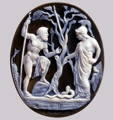
Athletic & Peaceful Endeavors
The silver tetradrachm (a coin worth 4 drachmae) of Athens that circulated widely in the ancient Mediterranean featured olive leaves on the helmet of Athena and an olive sprig next to Athena’s sacred animal, the owl. The Athenian tetradrachm (along with its olive leaves) was circulated around the Mediterranean and was used by friend and foe alike.
Here is an example of such a coin from 450-406 BC (now in the British Museum, London).


The sacred olive groves of Athens produced the oil that was given as prize to the winners of athletic competitions at the Panathenaic Games (in honor of Athena’s birthday).
The oil was presented in elegant amphoras decorated on one side with the relevant competition and on the other side with an image of the goddess. To this day vessels are commonly used as trophies (the Stanley Cup, Claret Jug, Wimbledon Trophy, and Americas Cup to name a few.)
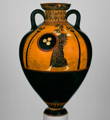

In fact, olive oil was central to athletic training, competitions and bodily care throughout the Greek world. Athletes would exercise and compete naked under the sun so they would preface any such activity by anoint their body with oil, to keep the skin hydrated, flexible, and protected (especially important during wrestling matches).
At the end of their exercise, they would scrap dust, sweat and oil from their skin with a strigil, bathe, and anointing themselves with fresh olive oil.

A prime example of the centrality of the olive tree in ancient Greek culture comes once more from the world of athletics: the most highly coveted athletic prize was the Olympic wreath made from the branches of a wild olive tree in the sanctuary of Zeus in Olympia.

According to tradition, the Olympic Games were established in 776 BC and were celebrated there every four years. Originally the games were open only to Greek athletes who, together with spectators, would travel to Olympia from all over the Greek world (from modern day Southern France to the Black Sea). Since travel could take months depending on the distance, and Greeks were often at war with each other over territorial disputes, a truce was established among all cities participating in the games, to allow safe passage to travelers and foster peaceful interaction among athletes. This tradition may have contributed to the use of the olive branch as a symbol of peace in ancient Greek tradition.
When the Olympic Games were celebrated in Athens in 2004, olive wreaths were once again offered to the winners in honor of the ancient tradition.
Christianity
In the 4th c. AC the adoption of Christianity led to the abolition of the Olympic Games and the gradual eradication of polytheism, but the olive tree remained deeply rooted in the evolving culture of the Greek world and took on new meanings from the Judeo-Christian tradition. The very name of Christ derives from the Greek word Christos, the anointed one (the one sanctified with the holy oil of royalty or with the grace of the Holy Spirit).
Pure oil is used today in the Orthodox rite of baptism to anoint those baptized as athletes of virtue in the name of Christ. "Chrism" (a sanctified and perfumed olive oil) is used to mark the sign of the cross on the body of the baptized and symbolize the grace of the Holy Spirit.

Since the Greek word for oil (elaion) is similar to the Greek word for mercy (eleos), a fruitful olive tree can be used as a symbol of charity. Christ himself is said to be the merciful and healing oil that mends the wounds of the world. Holy oil sanctified through contact with holy sites, bodies, and objects was used as a healing agent in the Byzantine world. Olive trees feature prominently in Byzantine art, especially in connection to Christ’s Ascension which according to the Bible took place on the Mount of Olives outside Jerusalem.
The prominent presence of olive plants on that mount did not only reflect the iconic flora of the land but it also symbolized the salvation of the world through the healing and merciful message of Christ who just before his ascension ordered his disciples to spread his teachings to the four corners of the earth.
A 15th-c. Cretan icon of Christ’s Ascension, following the Byzantine iconography of the scene, with olive trees in the background.

Olives Today

The harvest of olives by Greek folk painter Theophilos Chatzimichael, 1933.
Today, Greek jewelry makers are inspired by the rich history and symbolism of the olive tree to produce delicate and auspicious treasures.
The Greek culture and economy are still closely intertwined with this gracious plant. Although Greece is only the 95th largest country in the world by population, it is the 3rd largest producer of olive oil.
Maria Evangelatou is a Professor of Mediterranean Studies, Department of History of Art and Visual Culture, University of California Santa Cruz.
Our gratitude to Maria for her research and contributions to this page.

